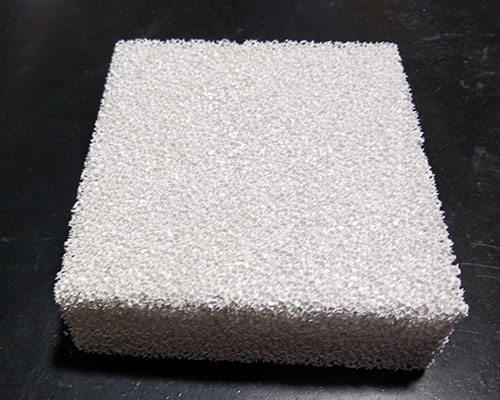Ceramic Foam Filter Function
- Impurity and slag removal: Purify the molten metal while degassing (adjust turbulence).
- The scrap rate of parts is reduced.
- Improved parts cutting performance.
- Material mechanical properties are significantly improved, especially elongation.
After filtration, the viscosity of the molten metal decreases, and the fluidity of the aluminum alloy liquid increases by 10%-15%. Therefore, the filtration improves the filling capacity of the molten metal.
Before ceramic foam filtering, the flow of molten metal is turbulent, and after filtering, it becomes laminar (the flow channel of the foam ceramic filter is twisted and turned), which reduces entrainment and secondary slagging;
As the filtration progresses, the ceramic foam filter function changes from sieving, filter cake to deep bed filtration, and the purity of the filtered molten metal is getting higher and higher (without exceeding the filtration capacity of the ceramic foam filter).
Selection of Ceramic Foam Filter Size
Step 1: Calculate the minimum cross-sectional area of the sprue
Step 2: Calculate the sum of the cross-sectional area of the runner, the sum of the cross-sectional area of the inner runner,
Step 3: determine the placement and number of filters;
Step 4: Determine the size of the ceramic foam filter according to the filtration speed of the filter per unit area, the filtration capacity of the filter per unit area, the actual pouring speed, and the weight of the molten metal passing through the filter, and the purity of the molten metal. If the liquid is too impure, multi-stage filtration is required).

Precautions
• Improper use of ceramic filters, the effect is worse than using other filters;
• The system design requires the molten metal to pass through the filter (if part of it does not pass, the molten aluminum is not pure, and generates turbulence, entrains gas and creates slag);
• The filtering area of the filter should be large enough to not affect the flow rate of the molten metal;
• There should be enough space before and after the filter to help collect the inclusions.
•The molten metal should be smelted in the melting furnace (to avoid oxidation, and slag removal treatment) and the refining and slagging and degassing of the holding furnace should be done. Because the filtering capacity of the filter is limited, too dirty molten metal will cause the filtered molten liquid to be more dirty than the filtered molten liquid.

